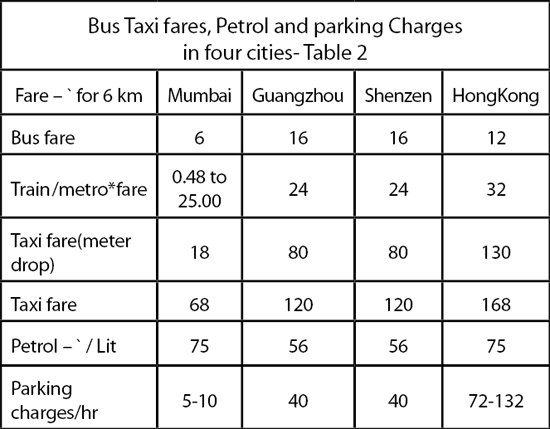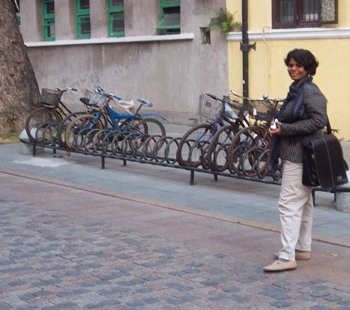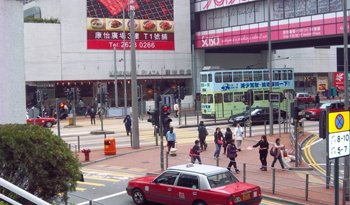 Besides convenience, the time required for the journey, the comfort of travel and the cost of various modes are major and quantifiable determinants in the choice of mode of transit for a city. While the cost of auto fuels is a little higher in Mumbai as compared to Guangzhou and Shenzhen with high incidence of cars and buses and metro, the availability of taxis is rather less in Guangzhou and Shen Zhen. In Guangzhou, there is a ban on motorised two wheelers, but the usage of bicycles is encouraged through a provision of bike parking stands and safe bike lanes in many areas and even major arteries. However, a large number of cars does lead to severe but non chaotic traffic jams especially in Guangzhou (this is due to good lane discipline and road markings). In Shen Zhen, traffic conditions are better as the various suburbs are spaced out and there is
Besides convenience, the time required for the journey, the comfort of travel and the cost of various modes are major and quantifiable determinants in the choice of mode of transit for a city. While the cost of auto fuels is a little higher in Mumbai as compared to Guangzhou and Shenzhen with high incidence of cars and buses and metro, the availability of taxis is rather less in Guangzhou and Shen Zhen. In Guangzhou, there is a ban on motorised two wheelers, but the usage of bicycles is encouraged through a provision of bike parking stands and safe bike lanes in many areas and even major arteries. However, a large number of cars does lead to severe but non chaotic traffic jams especially in Guangzhou (this is due to good lane discipline and road markings). In Shen Zhen, traffic conditions are better as the various suburbs are spaced out and there is  extensive use of buses and metro. It is clear that unlike Mumbai, the gap between taxi and bus fare is much larger (in favour of buses) and this provides a strong incentive to people who don’t own or use private cars to use buses or metro. Even parking fee in Guangzhou and Shen Zhen is much higher than in Mumbai – although not as high as Hong Kong!
extensive use of buses and metro. It is clear that unlike Mumbai, the gap between taxi and bus fare is much larger (in favour of buses) and this provides a strong incentive to people who don’t own or use private cars to use buses or metro. Even parking fee in Guangzhou and Shen Zhen is much higher than in Mumbai – although not as high as Hong Kong!
Restricted space availability and high (in absolute terms as well as in relation to the cost of fuel or the public transport) parking charges have strongly dampened the use of cars in Hong Kong where cost of parking per hour is higher than the cost of auto fuel per litre. While the fare for meter drop is three to four times higher in Chinese cities, the fare for 6km (and above) is not much high when compared with India. We need to understand this point while fixing the tariff which should be telescopic for long distances.
Shen Zhen has 600 fully electric taxis and a small fleet of 12 electrically operated buses. This is its focus area and it hopes that within the next three years, it will achieve exponential growth in the number of taxis and buses running on electricity.
 The above table compares the cost of public and private transport in these four cities. Although the cost of petrol in Guangzhou and Shen Zen is lower, the taxi fare/km is much higher than Mumbai (price of diesel in China is not very low than price of petrol in China). Almost in all the cities, the cost of metro is much high than the buses whereas in Mumbai, it is the other way around. It is high time we work towards correcting the balance between the cost of train ride and bus ride and make these modes complimentary to each other. In fact, if both of them were under one authority, it would be possible that a common ticket on an hourly basis can be used for rail and buses (especially for the last mile connectivity). In Hong Kong, it is possible to shift between buses and metro very easily, clearly and quickly – helped by proximity and excellent signage and maps. At the same time, buses score over metro in this most transport efficient city due to very easy accessibility, deeper penetration, high frequency and lower price. In spite of an outstanding metro network in all the South Chinese cities – and more particularly in Hong Kong, the buses handle more trips per day than the metro. It is true even in London and hence, we should never lose focus from buses while planning for a rail network.
The above table compares the cost of public and private transport in these four cities. Although the cost of petrol in Guangzhou and Shen Zen is lower, the taxi fare/km is much higher than Mumbai (price of diesel in China is not very low than price of petrol in China). Almost in all the cities, the cost of metro is much high than the buses whereas in Mumbai, it is the other way around. It is high time we work towards correcting the balance between the cost of train ride and bus ride and make these modes complimentary to each other. In fact, if both of them were under one authority, it would be possible that a common ticket on an hourly basis can be used for rail and buses (especially for the last mile connectivity). In Hong Kong, it is possible to shift between buses and metro very easily, clearly and quickly – helped by proximity and excellent signage and maps. At the same time, buses score over metro in this most transport efficient city due to very easy accessibility, deeper penetration, high frequency and lower price. In spite of an outstanding metro network in all the South Chinese cities – and more particularly in Hong Kong, the buses handle more trips per day than the metro. It is true even in London and hence, we should never lose focus from buses while planning for a rail network.
Parking is the most important (but ignored in Mumbai) Variable
In Hong Kong, the efficiency of public transport – in spite of the narrow streets and high density – is due to very sensible pricing and regulation of parking. This allows sufficient space for buses/ trams and provides enough passengers at all times to buses. Very little subsidy is provided to any form of public transport. While Guangzhou and Shen Zhen have not yet introduced any serious restraints on private cars so far, parking regulation/pricing is a fairly strong factor that goes in favour of public transport. In Hong Kong, there are very high parking charges – at `100 and above per hour during day time and on monthly basis, they work out to `20,000 and above for night time parking and weekends at residences.
 Mumbai has to learn from their very high preponderance – for high rise residential and commercial buildings with extensive mixed land use, they don’t provide any “incentive and free FSI for parking” at all. While in Mumbai, we provide free FSI equal to two parking spaces – 400sqft – for every flat of 700sqft. In Hong Kong, there is no free FSI for parking and the permitted FSI is only one space for every 2000sqft of built up area. This has been the biggest dampener for people to buy/maintain cars while living in high rises. The cost of parking is much more than the purchase value of even the fanciest and expensive cars! At the same time, the urban design provides extensive (and heavily used) skywalks which connect through the commercial buildings at ground and up to two higher levels. This enables people (across all income groups) to walk. There is also very easy access to either a metro station or a bus stop and between the buses and metro. Hence Hong Kong does not look dense on road but reaps all the advantages of density.
Mumbai has to learn from their very high preponderance – for high rise residential and commercial buildings with extensive mixed land use, they don’t provide any “incentive and free FSI for parking” at all. While in Mumbai, we provide free FSI equal to two parking spaces – 400sqft – for every flat of 700sqft. In Hong Kong, there is no free FSI for parking and the permitted FSI is only one space for every 2000sqft of built up area. This has been the biggest dampener for people to buy/maintain cars while living in high rises. The cost of parking is much more than the purchase value of even the fanciest and expensive cars! At the same time, the urban design provides extensive (and heavily used) skywalks which connect through the commercial buildings at ground and up to two higher levels. This enables people (across all income groups) to walk. There is also very easy access to either a metro station or a bus stop and between the buses and metro. Hence Hong Kong does not look dense on road but reaps all the advantages of density.
Parking is one of the most important elements in urban planning. It is, unfortunately, not understood in Mumbai. Development control rules provide compulsory (but abundant & free) parking which ends up with more construction of flats with cars in congested areas and narrow roads. In effect, the development control rules actually encourage more cars and congestion instead of following any pro public transport or car restraint measures!
 TrafficInfraTech Magazine Linking People Places & Progress
TrafficInfraTech Magazine Linking People Places & Progress